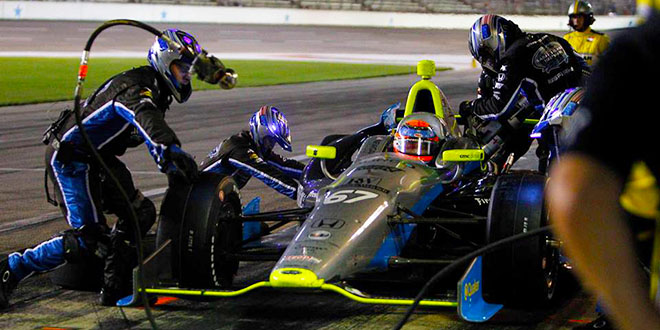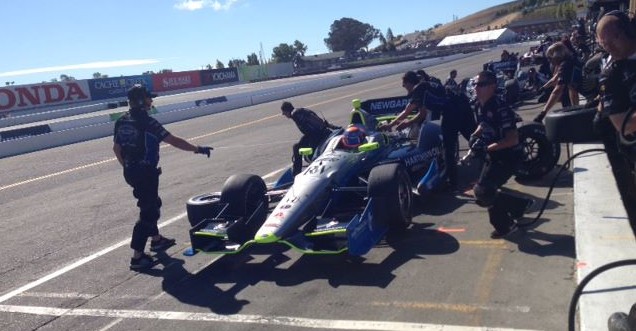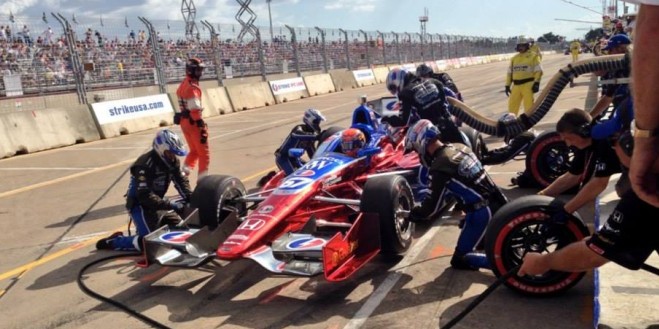By: Aaron Fischman
In the world of professional auto racing, fractions of a second can mean the difference between winning a race and not even finishing in the top three. Imagine the damage an extra five seconds could do.
For all the speed and three-wide passing that brings the fans to their feet, often those precious seconds are either gained or lost during the pit stops. The guys who go over the wall, the guys filling up the gas tank and jacking up the car and changing the tires, have to be in supreme athletic condition, which is why Sarah Fisher Hartman Racing — which owns the No. 67 car in the IndyCar Series driven by Josef Newgarden — requires each of its six pit-crew members to maintain a strict workout regimen.
“The fitter you are when you do a pit stop, [the clearer you can think],” said crew Chief Anton Julian. “When you’re out of shape, that’s when people start panicking, because they think they’re behind or they’re slower than everyone else. It causes them to make more mistakes, because they’re not calm and collected in their situations.”
Community Health Network provides a personal trainer for the team, and the guys like to focus on specific upper-body movements that will best simulate what they do during races. Naturally, developing hand-eye coordination is also extremely important.
After even a long race like [the] Indy [500], where you do six, eight pit stops, you kind of find muscles you didn’t realize you had that are important with what you do,” said Danny Klotz. “It’s extremely important to have strong shoulders [and a] strong body to make sure you have the quickest and best pit stop possible.”
Klotz, who served as a tire catcher for the past few years, finally went over the wall for the first time this season.
No one forgets their first time.
For Klotz, it came in St. Petersburg, Fla. at the season opener. Before every race, the team goes over its strategy and discusses its pit window (the laps between which they expect to make their first pit stop).
For the St. Petersburg race, Klotz expected to make his over-the-wall debut between laps 20 and 29. Instead, a caution flag came out early, springing Klotz into action much earlier than anticipated.
“In a split second we’re being told to go over the wall, because we’re going to do a stop,” recalled Klotz.
At that point, adrenaline kicked in, and Klotz’s first over-the-wall experience was over before he knew it.
“I didn’t have time to think about it, really, which I think was the best way for it to happen. Everything went well, and as soon as Josef pulled out of the pit box, I was ready for him to come back in and do another one.”
Crew chief Julian has been going over the wall for 12 years. By now, the practice has become old hat for him. The muscle memory is there, and he doesn’t feel much pressure during races.
Between the six guys who go over the wall for SFHR, there’s an optimal blend of youth and experience. At the same time, compared to most teams, they are pretty young, with Julian, 40, the oldest team member, and no one else over 31 years old.
Of course, just because the guys are part of the same racing team doesn’t mean there isn’t internal competition among the team’s members.
We are extremely competitive with each other,” said Klotz. “We tend to get into push-up competitions or who can do another rep or who can run the mile faster.”
It’s not uncommon for the guys to pace themselves for a training run before launching into an all-out sprint at the very end in an effort to earn bragging rights. There’s also no shortage of good-natured ribbing, as one might expect from a group of competitive men.
One particularly common topic, rife with comedic fodder, is Julian’s age. The New Zealand native turned 40 in May, which has also noticeably affected how he takes care of his body.
“I think his whole year of being 39 until his recent birthday, he kind of had a midlife crisis with trying to be as healthy and as fit as possible,” said Klotz, who estimated that Julian now does two or three extra workouts per week to make sure he remains on top of his game.
“He eats a lot more health-conscious than we do,” added Klotz.
While Klotz and some of the other guys might occasionally make an age-related crack at Julian’s expense, Klotz is quick to add that the crew chief looks about 10 years younger than his actual age.
Either way, the 40-year-old never uses age as an excuse. When asked why he started performing extra workouts, Julian, half-jokingly, likes to say, “Cuz I want to kick their ass.”
Joking aside, each member of the pit crew and the racing team, as a whole, must rely on one another to perform at their best. Of course, the driver, Newgarden, needs the pit crew to be on its game so that he can get back out on the track as quickly as possible. And if even one member of the pit crew errs ever so slightly, it reflects poorly on everyone.
“Whenever you have a team effort, where you’re only as strong as your weakest link, it’s huge to have that camaraderie and [for] everyone to be on the same page,” said Klotz.
Keeping up with the workouts and maintaining a healthy diet may be challenges in their own right, but the mental toll a racing season can have on a team might even be greater.
“Mentally, you have to be just as sharp at the end as you were at the beginning,” according to Sharp. And that’s easier said than done with 16-hour days on occasion.
In fact, Klotz estimates the team sometimes works up to 100-hour weeks. By October, team members are ready for the offseason. But sure enough, after just four weeks off, Klotz and company are typically raring to get back into action.
No wonder Klotz calls it a “beautiful sickness.”
Despite the grueling physical and mental work these men must endure, they always come back wanting more.
 ATLX The only sports entertainment television and digital media network fully devoted to everyday athletes, athletic lifestyle and athletic culture.
ATLX The only sports entertainment television and digital media network fully devoted to everyday athletes, athletic lifestyle and athletic culture.









